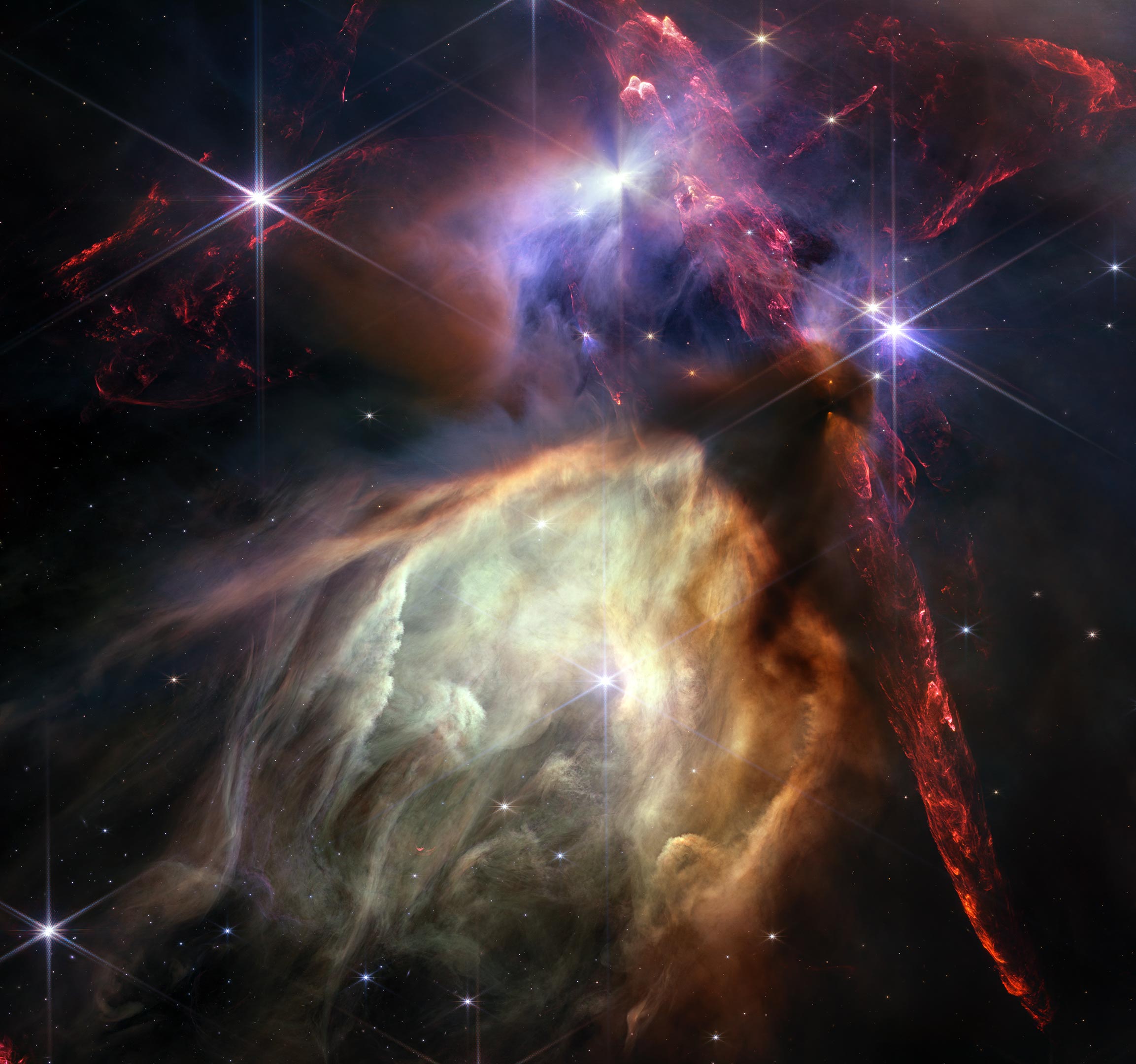NASA의 James Webb Space Telescope에서 촬영한 이 1주년 기념 이미지는 인상적인 디테일과 질감으로 가득한 이전과는 다른 별의 탄생을 보여줍니다. 주제는 지구에서 가장 가까운 별 형성 지역인 Rho Ophiuchi 구름 복합체입니다. 비교적 작고 조용한 별 보육원이지만 Webb의 지저분한 클로즈업에서는 결코 알 수 없습니다. 어린 별에서 흘러나오는 제트가 이미지를 가로지르며 주변의 성간 가스를 때리고 수소 분자를 비추며 빨간색으로 표시됩니다. 일부 별은 미래의 행성계를 구성하는 성간 원반의 선명한 그림자를 보여줍니다.
이 원반의 중심에 있는 어린 별들은 질량이 태양과 비슷하거나 작습니다. 이 이미지에서 가장 무거운 것은 별 S1로, 이미지 하단의 항성풍에 의해 조각된 빛나는 동굴 속에 나타납니다. S1을 둘러싼 밝은 색 가스는 우주에서 발견되는 가장 흔한 화합물 중 하나인 탄소질 분자 계열인 다환 방향족 탄화수소로 구성됩니다.
크레딧: NASA, ESA, CSA, STScI, Klaus Pontoppidan(STScI), Alyssa Pagan(STScI)
NASA의 제임스 웹 우주망원경은 상대적으로 조용한 별 형성 지역을 방해하는 액션으로 가득 찬 이미지로 계속 눈부시게 빛나고 있습니다.
James Webb Space Telescope caps a successful first year of science, and stunning imagery, with a detailed view of the closest star-forming region to Earth, the Rho Ophiuchi cloud complex, resulting in a dynamic image that belies the region’s relative quiet – and practically begs for explanation of what exactly we are looking at. While dual jets have been seen blasting out of new stars before, the texture that Webb’s NIRCam instrument reveals in the multiple jets crisscrossing the image is unprecedented. In striking contrast, the lower half of the image is dominated by a glowing cave of dust being lit up and eroded by the most massive star in the scene. Its stellar neighbors are the mass of our Sun or smaller, with some displaying the telltale shadows of protoplanetary disks—meaning we are looking at planetary systems potentially similar to our own in their earliest stages.

Image of star formation in the Rho Ophiuchi cloud complex, with compass arrows, scale bar, and color key for reference.
The north and east compass arrows show the orientation of the image on the sky. Note that the relationship between north and east on the sky (as seen from below) is flipped relative to direction arrows on a map of the ground (as seen from above).
The color key shows which filters from Webb’s NIRCam (Near-Infrared Camera) instrument were used when collecting the light. The color of each filter name is the visible light color used to represent the infrared light that passes through that filter.
Credit: NASA, ESA, CSA, STScI, Klaus Pontoppidan (STScI), Alyssa Pagan (STScI)
Webb Space Telescope Celebrates First Year of Science With Close-up on Birth of Sun-like Stars
From our cosmic backyard in the solar system to distant galaxies near the dawn of time, NASA’s James Webb Space Telescope has delivered on its promise of revealing the universe like never before in its first year of science operations. To celebrate the completion of a successful first year, NASA has released Webb’s image of a small star-forming region in the Rho Ophiuchi cloud complex.
“In just one year, the James Webb Space Telescope has transformed humanity’s view of the cosmos, peering into dust clouds and seeing light from faraway corners of the universe for the very first time. Every new image is a new discovery, empowering scientists around the globe to ask and answer questions they once could never dream of,” said NASA Administrator Bill Nelson. “Webb is an investment in American innovation but also a scientific feat made possible with NASA’s international partners that share a can-do spirit to push the boundaries of what is known to be possible. Thousands of engineers, scientists, and leaders poured their life’s passion into this mission, and their efforts will continue to improve our understanding of the origins of the universe – and our place in it.”
The new Webb image released on July 12 features the nearest star-forming region to us. Its proximity at 390 light-years allows for a highly detailed close-up, with no foreground stars in the intervening space.
“On its first anniversary, the James Webb Space Telescope has already delivered upon its promise to unfold the universe, gifting humanity with a breathtaking treasure trove of images and science that will last for decades,” said Nicola Fox, associate administrator of NASA’s Science Mission Directorate in Washington. “An engineering marvel built by the world’s leading scientists and engineers, Webb has given us a more intricate understanding of galaxies, stars, and the atmospheres of planets outside of our solar system than ever before, laying the groundwork for NASA to lead the world in a new era of scientific discovery and the search for habitable worlds.”
Webb’s image shows a region containing approximately 50 young stars, all of them similar in mass to the Sun, or smaller. The darkest areas are the densest, where thick dust cocoons still-forming protostars. Huge bipolar jets of molecular hydrogen, represented in red, dominate the image, appearing horizontally across the upper third and vertically on the right. These occur when a star first bursts through its natal envelope of cosmic dust, shooting out a pair of opposing jets into space like a newborn first stretching her arms out into the world. In contrast, the star S1 has carved out a glowing cave of dust in the lower half of the image. It is the only star in the image that is significantly more massive than the Sun.
이 비디오는 지구에서 가장 가까운 별 형성 지역인 Rho Ophiuchi 구름 단지의 일부를 둘러봅니다. 이 이미지는 NASA의 제임스 웹 우주 망원경의 과학 작업 시작 1주년을 기념하기 위해 촬영되었습니다. 어린 별에서 흘러나오는 제트는 이미지를 가로지르며 주변의 성간 가스를 때리고 수소 분자를 비추며 빨간색으로 표시됩니다. 일부 별은 미래의 행성계를 구성하는 성간 원반의 선명한 그림자를 보여줍니다. 옛날 옛적에 우리가 알고 있는 생명의 전체 역사를 포함하는 태양계 전체를 멀리서 보면 이와 같은 모습을 보일 것입니다. 하단에는 빛나는 먼지 동굴이 이미지를 지배합니다. 그것은 공동의 중심에 있는 별 S1에 의해 조각되었습니다. 이미지에서 우리 태양보다 훨씬 더 무거운 유일한 별입니다. 크레딧: NASA, ESA, CSA 및 Greg Bacon(STScI)
“Webb의 Rho Ophiuchi 이미지를 통해 별의 수명 주기에서 매우 짧은 기간을 새로운 선명도로 볼 수 있습니다. 메릴랜드 주 볼티모어에 있는 Space Telescope Science Institute의 Webb 프로젝트 과학자는 망원경이 출시되기 전부터 첫해까지 일했습니다. 메릴랜드 주 볼티모어에서 Webb의 프로젝트 과학자로 근무한 Klaus Pontopidan은 말했습니다.
사진 속 스타들 중 일부는 이야기를 제공합니다. 그림자는 나타냅니다 원형 행성 원반 – 제작 중인 미래 행성 시스템 가능성. 사진 동영상 둘러보기(위에 포함됨)에서 자세한 내용을 알아보거나 확대/축소 가능한 이미지.
1년 내내 온 하늘을 가로질러
조 바이든 대통령, 카말라 해리스 부통령, 넬슨이 백악관에 살고 있는 첫 번째 딥 필드 사진에서 웹은 그 어느 때보다 더 많은 우주를 우리에게 보여주겠다는 약속을 지켰습니다. 그러나 Webb은 초기 우주에서 멀리 떨어진 은하 이상을 밝혀냈습니다.
NASA 본부 천체물리학부 연구 부국장이자 웹 프로그램 과학자인 에릭 스미스(Eric Smith)는 말했다. “Webb의 과학 첫해는 우리 우주에 대한 새로운 사실을 가르쳐 주었을 뿐만 아니라 망원경의 능력이 우리가 예상했던 것보다 훨씬 더 크다는 것을 보여주었고 이는 미래의 발견이 훨씬 더 놀랍다는 것을 의미합니다.” 전 세계 천문학 커뮤니티는 지난 1년 동안 Webb의 원시 공개 데이터를 미친 듯이 살펴보고 작업 방법을 알아냈습니다.
Rho Ophiuchi 클라우드 컴플렉스로 이동합니다. 여행은 천체 사진가 후지이 아키라가 찍은 지상 사진으로 시작하여 디지털 하늘 측량 패널로 전환됩니다. 다음으로 퇴역한 NASA 스피처 우주망원경에서 촬영한 2색 이미지가 나타나더니 마침내 제임스 웹 우주망원경의 별 탄생 지역 이미지에 이르게 됩니다. 웹 이미지에 포착된 별 형성 영역은 작고 알려진 다른 별 형성 영역에 비해 특별히 활성화되지 않습니다. Webb가 젊은 태양 질량 별에서 방출되는 제트 구조와 빛나는 PAH의 먼지 투성이 “동굴”에 초점을 맞추면서 이 지역을 지구와 근접(390광년)했기 때문입니다. 크레딧: NASA, ESA, CSA, Alyssa Pagan(STScI)
놀라운 적외선 이미지 외에도 과학자들의 흥미를 끈 것은 Webb의 겉보기 스펙트럼, 즉 망원경의 분광 장비를 통해 빛에서 추출할 수 있는 자세한 정보였습니다. Webb의 스펙트럼은 지금까지 관측된 가장 먼 은하 중 일부의 거리를 확인했으며 가장 오래되고 가장 먼 초대질량 블랙홀을 발견했습니다. 그들은 그 어느 때보다 더 자세하게 행성의 대기 구성(또는 구성 부족)을 결정했으며 처음으로 암석 외계 행성에 존재할 수 있는 대기 유형을 집계했습니다. 그들은 또한 항성 보육원과 원형 행성 원반의 화학적 조성, 발견된 물, 탄소 함유 유기 분자 등을 밝혀냈습니다. 이미 Webb의 관찰은 오랜 질문에 답하고 Webb과 함께 해결할 새로운 질문을 제기하는 수백 개의 과학 논문으로 이어졌습니다.
Webb 과학의 폭은 우리가 가장 잘 아는 우주 영역인 태양계에 대한 그의 관찰에서도 분명합니다. 가스 거인의 희미한 고리가 어둠 속에서 나타나고 달이 강조 표시되며 Webb은 배경에 먼 은하를 보여줍니다. 우리 태양계의 물 및 기타 분자의 발견을 훨씬 더 작은 다른 행성계의 원반에 있는 것과 비교함으로써 Webb은 우리의 기원, 즉 지구가 어떻게 우리가 알고 있는 생명체의 완벽한 고향이 되었는지에 대한 단서를 구축하는 데 도움을 주고 있습니다.
Goddard Space Flight Center의 Webb 수석 프로젝트 과학자인 Jane Rigby는 “1년 간의 과학 연구를 통해 우리는 이 망원경이 얼마나 강력한지 알고 있으며 놀라운 데이터와 발견을 1년 동안 제공했습니다.”라고 말했습니다. “우리는 야심 찬 그룹을 선택했습니다. 두 번째 해에 대한 메모 그것은 우리가 지금까지 배운 모든 것을 기반으로 합니다. Webb의 과학 임무는 이제 막 시작되었습니다. 앞으로 더 많은 일이 있을 것입니다.”
제임스 웹 우주 망원경은 세계 최고의 우주 과학 관측소입니다. Webb은 우리 태양계의 미스터리를 풀고, 다른 별 주변의 먼 세계를 바라보고, 미스터리한 구조와 우주의 기원 및 그 안에 있는 우리의 위치를 조사합니다. Webb은 NASA가 파트너인 ESA와 함께 주도하는 국제 프로그램입니다.[{” attribute=””>European Space Agency) and the Canadian Space Agency.

“음악 팬. 매우 겸손한 탐험가. 분석가. 여행 괴짜. 익스트림 TV 전문가. 게이머.”






More Stories
Legionnaires는 이 특별한 럭셔리 기능과 연결된 두 개의 별도 크루즈를 타고 출발합니다.
120년의 성장 끝에 일본 대나무가 이제 막 꽃을 피우고 있는 것이 문제다.
SpaceX, 10월 30일 캘리포니아에서 20개의 Starlink 인터넷 위성 발사